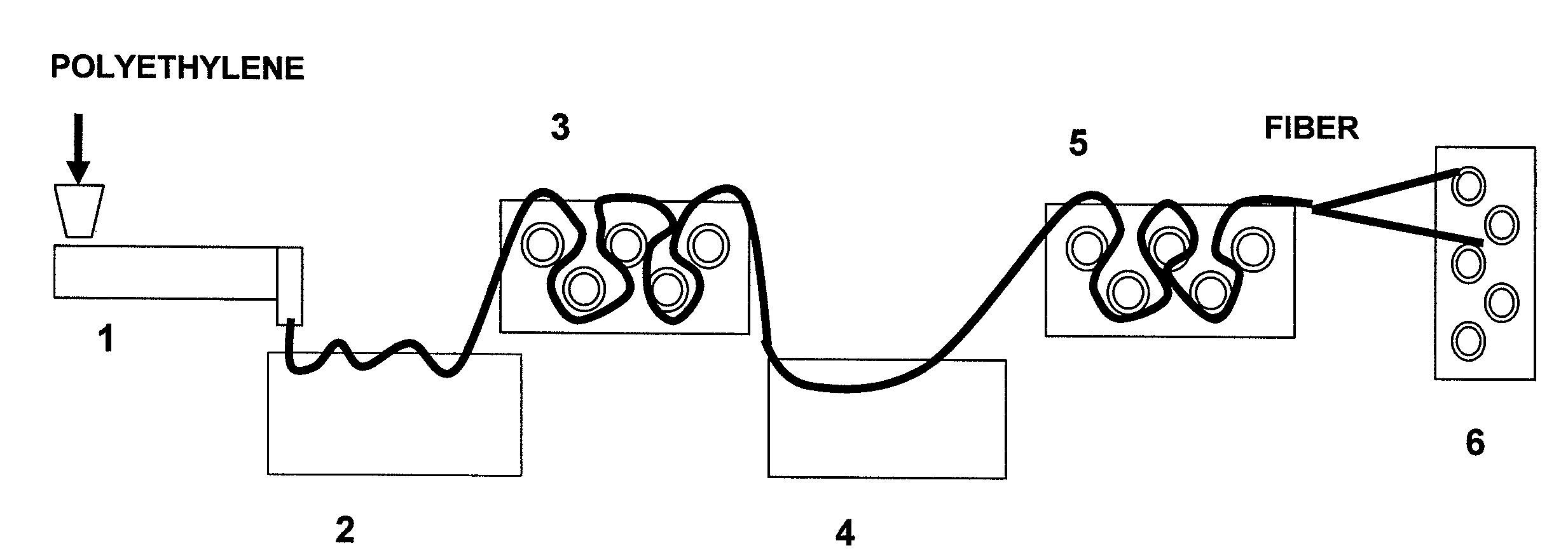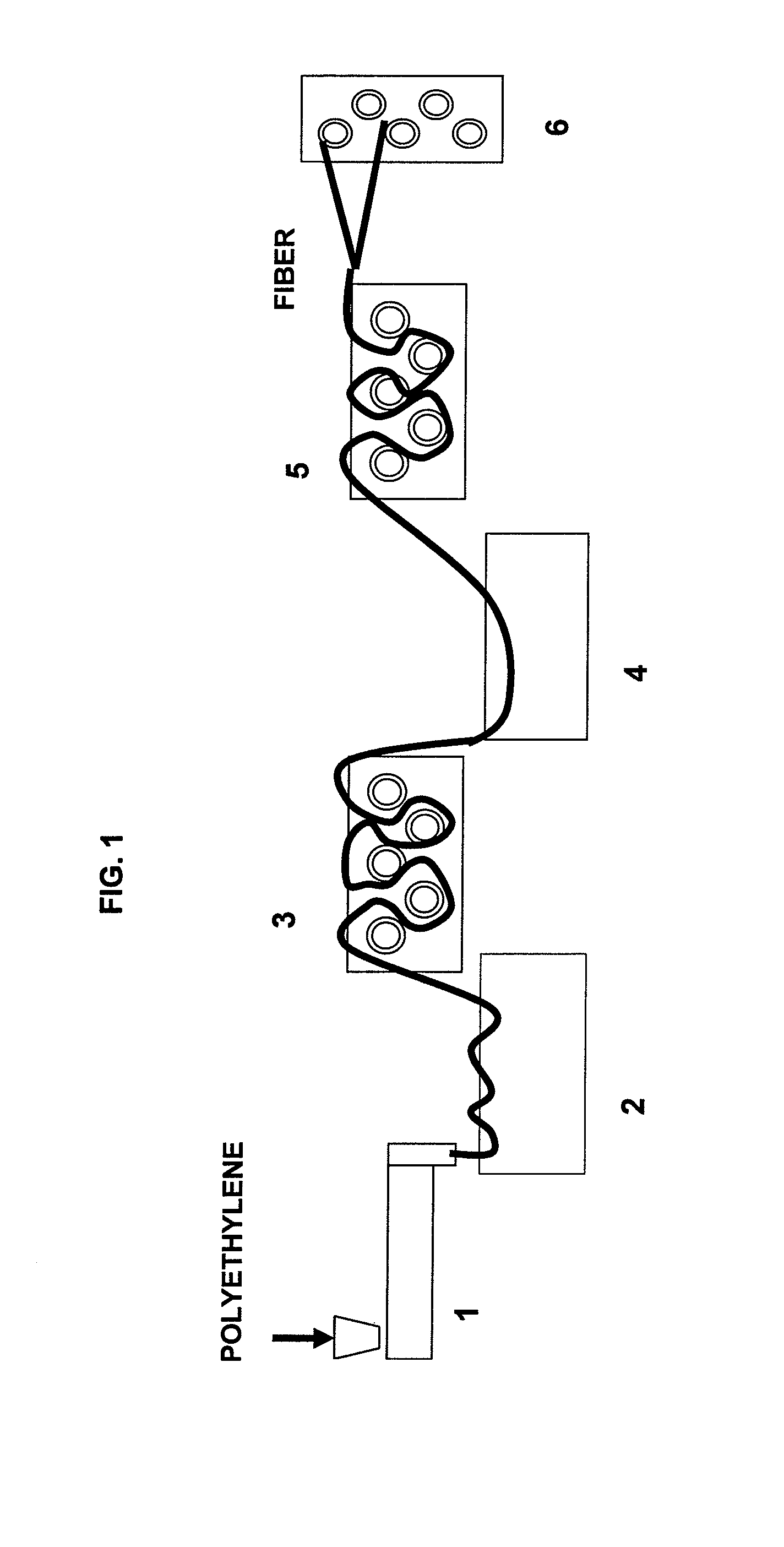Fiber and process for obtaining same from high-modulus, extrudable polyethylene
a technology of extrudable polyethylene and fiber, which is applied in the field of fiber, can solve the problems of high cost of the overall process, drawback to users, and special measures, and achieve the effect of a large industrial application of fiber material and higher tenacity
- Summary
- Abstract
- Description
- Claims
- Application Information
AI Technical Summary
Benefits of technology
Problems solved by technology
Method used
Image
Examples
example 1
[0087] To a 4-liter capacity reaction vessel are added 2 liters of n-hexane. The system is heated to 50° C. and then 0.8 mL of a 0.9M triethylaluminum (TEA) solution and 1.8 mL of a suspension of catalyst supported on a mixture of 30% by mass magnesium chloride / 70% by mass alumina are added, containing 1.2% by mass titanium. Then, the temperature is raised to 70° C. and hydrogen is introduced at a pressure of 2.0 bar. Ethylene monomer is then continuously fed at a 6.0 bar pressure, for 1 hour. The temperature is raised to 85° C. by the polymerization reaction exotherm and is kept at this level by cooling with external water.
[0088] The polyethylene product obtained has the following properties:
[0089] Melt flow index MI21: 1.6 g / 10 min
[0090] melting point: 135° C.
[0091] Vicat softening temperature: 130° C.
[0092] specific weight: 0.95 g / cm3
[0093] tensile strength: 320 kg / cm2
[0094] Izod impact strength: does not break
[0095] Taber abrasion: 40 mg / 1000 rotations
[0096] Rockwell Ha...
example 2
[0098] A polyethylene prepared as in Example 1 is submitted to extrusion in an industrial, state-of-the-art extruder provided with a head having an orifice diameter of 1.2 mm, screw velocity 35.9 RPM, using as temperature profile 220-230-250-255-260° C., with a productivity of 5.2 g / min. The extrudates are stretched at a 64 / 1 draw ratio, the fibers having 1305 denier and 4.2 gf / den tenacity.
example 3
[0099] To a 4-liter capacity reaction vessel are added 2 liters of n-hexane. The system is heated to 50° C. and then 1.2 mL of a 0.9M triethylaluminum (TEA) solution and 1.6 mL of a suspension of catalyst supported on a mixture of 30% mass magnesium chloride / 70% mass alumina are added, containing 1.5% mass titanium. Then, the temperature is raised to 70° C. and hydrogen is introduced at a pressure of 1.5 bar. Ethylene monomer is then continuously fed at a 6.0 bar pressure, for 1 hour. The temperature is raised to 85° C. by the polymerization reaction exotherm and is kept at this level by cooling with external water.
[0100] The polyethylene product obtained has the following properties:
[0101] Melt flow index MI21: 0.9 g / 10 min
[0102] melting point: 135° C.
[0103] Vicat softening temperature: 130° C.
[0104] specific weight: 0.95 g / cm3
[0105] tensile strength: 380 kg / cm2
[0106] Izod impact strength: does not break
[0107] Taber abrasion: 40 mg / 1000 rotations
[0108] Rockwell Hardness: 7...
PUM
| Property | Measurement | Unit |
|---|---|---|
| tensile strength | aaaaa | aaaaa |
| linear density | aaaaa | aaaaa |
| melt index | aaaaa | aaaaa |
Abstract
Description
Claims
Application Information
 Login to View More
Login to View More - R&D
- Intellectual Property
- Life Sciences
- Materials
- Tech Scout
- Unparalleled Data Quality
- Higher Quality Content
- 60% Fewer Hallucinations
Browse by: Latest US Patents, China's latest patents, Technical Efficacy Thesaurus, Application Domain, Technology Topic, Popular Technical Reports.
© 2025 PatSnap. All rights reserved.Legal|Privacy policy|Modern Slavery Act Transparency Statement|Sitemap|About US| Contact US: help@patsnap.com


